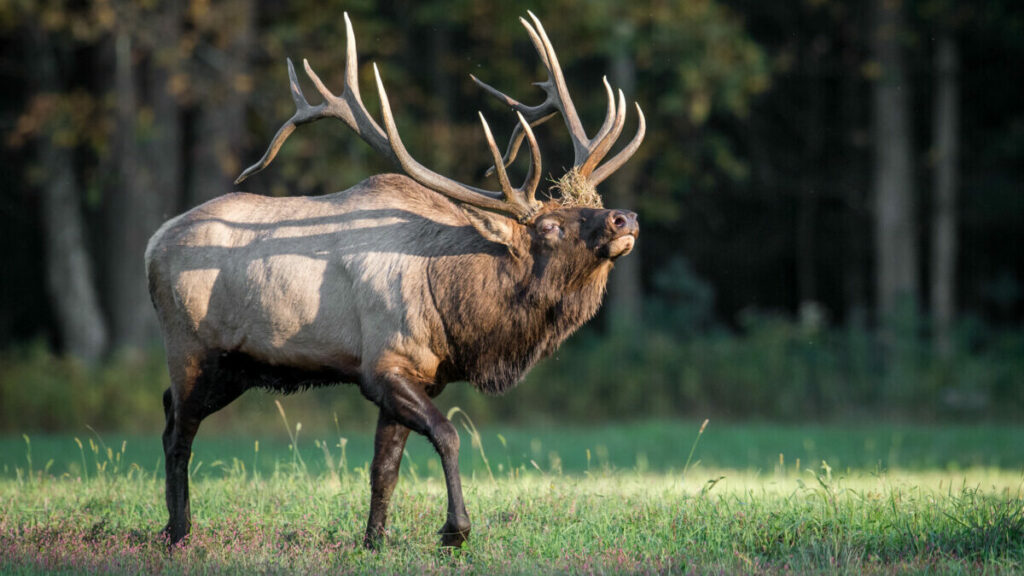
Getting Started Elk Calling
When it comes to elk calling, it is easy to get intimidated. Diaphragms, tubes, and violent opinions can be found everywhere and anywhere there are elk hunters. It can downright turn you off from even getting started. However, there is still hope for the new elk hunter.
The easiest elk bugle to use is the Mac Daddy Call from Hunter Specialities. All you have to do is blow into a tube and then push on a button to change the sound being made. It is so easy anyone can do it. It is highly affordable, widely available, and simple to use. If you have never called in an elk before, the Mac Daddy Call from Hunter Specialties will be the easiest elk bugle to use you will be able to find.
An under-celebrated attribute of the Mac Daddy is its ability to become a cow call in an instant. Elk are primarily hunted in mountainous terrain. Backpack hunting forces a hunter to be very selective about what they bring with them into elk country.
Any chance to reduce weight and complexity must be taken seriously. Since the Mac Daddy can be changed to a cow call by simply pulling off the tube, it allows hunters to have two calls in one. This makes for a reduced risk of losing a call, enhanced packability, and reduced weight.
(Pinetrees and solitude may earn a commission from affiliate links in this article.)
Though easy, the Mac Daddy is far from the best. Another call to consider is the Primos Terminator. It is also easy to use but requires a little more understanding of manipulating a call to get positive reactions from elk.
The Primos Terminator can be a victim of its own success as many people use them. In high-pressure areas, there are likely to be several hunters using them. This leads to the elk being call shy and specifically wary of the unique sounds made by the Terminator.
If it is the quality of sound and versatility you want, but don’t mind suffering through the learning curve, consider a diaphragm and tube. By far, the best elk call is that tried and true combination. Phelps Game Calls is particularly well known for their diaphragm and un-Rival-ed Tube combination.
They provide a wide variety of diaphragms to choose from that fit every hunter and every situation. Though, mastering the diaphragm call will have you practicing in your vehicle to and from work in order to get the sounds right.
No matter what call you choose, you must practice in order to be effective. Even when using something as easy as the Mac Daddy, it still requires knowing how and when to employ the call to be effective. That requires an intense study of elk’s vocalizations and time spent trying to imitate them.
Understanding Elk Vocalizations
Elk Vocalizations
While the bugle is well known, many of the other vocalizations and their purposes aren’t. Elk are complex social creatures. That level of complexity requires a much larger pallet of sounds to facilitate communication. In order to be an effective elk caller, you have to know them all to take part in the conversation.
The “bugle” is, by far, the most easily recognized and majestic of all the elk sounds. Most everyone that has any interest in elk knows the distinct sound of an elk bugle. The bugle is used primarily as a way to locate other elk and establish dominance hierarchies. Mature bulls will use the sound of a bugle to locate competition to push out of the area. While this is the most important call for a hunter to know, it is not the only one.
A “chuckle” often follows behind the bugle and is a common vocalization for large bulls. Often times a chuckle will follow a long bugle, but they can be done completely on their own as well. Though the sound is different than a bugle, it serves the same purpose. Bull elks will chuckle to locate other elk for mating or to defend their own herd from intruders.
The “bark” is another call that should be well known to the hunter. When an elk is alerted to a threat or danger, they will typically let out a high-pitched, but short, barking sound. This sound coming from a cow will cause a bull to immediately blow out of an area and head for safety. Though you won’t want to imitate this vocalization, you will want to be aware of what it means if you hear it.
A “mew” is the sound that is often made by cows. This is the most common of all elk vocalizations and is used for a wide variety of purposes. Given the flexibility of this vocalization, it should be mastered early on in the elk hunters career. Cow elk can easily be imitated during the rut to coax a big bull into range as they will believe they are rounding up another potential mate.
Finally, the most benign of all the elk vocalizations is the “chirp”. Elk will emit high-pitched, quick sounds in order to communicate with one another. Typically, as elk graze and move about the landscape, they will emit short chirps in order to receive chirps in response.
This is much like two individuals making small talk in an elevator or at the dinner table. Elk are highly social and will seek interaction from one another on a regular basis. Though you likely won’t ever need to imitate a chirp, it can be an indicator that the elk you are stalking are undisturbed and calm.
The Messages Being Sent
Being able to imitate the sound an elk makes is one thing. It is fairly easy to listen to some videos online and slowly start to copy the sounds of elk. However, the real difference in elk callers is in how they understand and interpret those sounds. Elk communicate threats, opportunities, and social dynamics through their vocalizations. Properly interpreting those vocalizations is crucial to knowing when and how to call to them.
This is a difficult task for someone just starting to elk hunt. However, if you consider your dog, it will be much easier. Dogs are also highly social and have similar vocalization habits to elk. They will bark at different intensities and at different times depending on what is happening around them. There is a distinct difference between a dog barking because they are threatened and the dog that is barking playfully.
Elk are no different. They will bugle, chirp, and mew in different ways depending on the emotion they are feeling and want to communicate to the outside world. This can be seen most easily in the bugle. An elk bugling in order to warn a potential competitor is much different in tone and intensity than an elk that is bugling looking for cows to respond.
This is at the heart of understanding how to call to an elk. If a bull is calling in order to illicit a mew from a cow in order to breed with her, letting out a raging bugle will not have the desired effect. However, if you find yourself at a higher elevation from a long, well-pronounced bugle, offering a challenging bugle can bring that bull to you as he sees it as a challenge.
Similarly, doing frequent cow calls can be highly effective during the rut. However, if you find yourself listening to several bulls bugle at one another pre-rut, a cow call will likely get you nowhere. Understanding what the elk are attempting to communicate to one another is absolutely critical to being effective at calling to them.
Know Their Cycle
Another essential item to know and be attuned to in order to call effectively to elk is their annual cycle. Elk socialize throughout the year and generally are always a part of a larger herd. As the herd begins to focus on the rut, calving, or simply surviving through winter, their vocalization habits will change accordingly. It is vital that, as you call, you don’t offer up a vocalization that is out of place for the point in the cycle they are in.
Think if you were at an Independence Day party and someone said something about the Super Bowl being next week. You would immediately raise an eyebrow at this individual who is six months off on their football schedule. Making a bugle that is better suited to the pre-rut during late season is just such a social infraction. Not only will this not attract other elk, it has a high likelihood to flag yourself as a hunter.
Parting Thoughts
Calling elk is an art, not a science. It is a beautifully complex and challenging activity that can even rival hunting itself at times. The two main things to remember is that you will always need to be learning and that you must never give up.
If you enjoyed this article check these other great articles from Pinetrees and Solitude:
- What Should I Bring Elk Hunting? Idaho Checklist
- Are Guided Elk Hunts Worth The Cost? Find Out Here
- The Best Time To Hunt Elk: Master Elk Habits
(This article was originally published on Pintreesandsolitude.com. If it is now published on any other site, it was done without permission from the copyright owner.)
